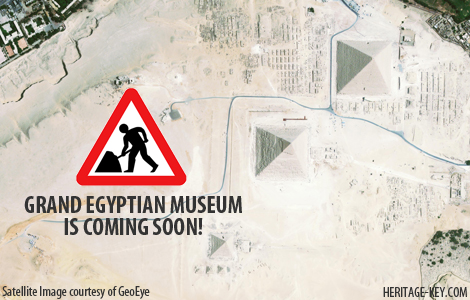 Finished in 2560 BC, the Great Pyramid of Giza took 20 years to build. 3,000 years on, it doesn’t look like major Egyptian construction projects have hurried up any.
Finished in 2560 BC, the Great Pyramid of Giza took 20 years to build. 3,000 years on, it doesn’t look like major Egyptian construction projects have hurried up any.
It was recently announced that the opening date for the Grand Egyptian Museum – the massive centerpiece attraction of the epic new vision for the Giza plateau, two and a half kilometres from the pyramids – has been pushed back to 2013, after the latest in a long-running series of delays for the building. The project was officially commenced in 1992, which means that even if the GEM does open on schedule now, it will itself have taken at least a full 20 years to finally come to fruition. History never lacks a sense of irony, does it?
To be fair, the GEM is no small undertaking. With a 100,000 square metres of floor space – the size of 11 football pitches – it’s intended to be an almighty construction that will house over 100,000 artefacts (most significantly Howard Carter’s Tutankhamun collection) and cost a staggering $550 million. Three million visitors a year – around a quarter of all tourists who visited Egypt in 2008 – are hoped to pass through its doors, at a rate of 15,000 a day.
The foundation stone for the GEM was laid as far back as 2002, while the architectural competition for the design of the building – which will be shaped like a chamfered triangle, with a great stone roof – was won by Irish company Heneghan Peng from Dublin in 2003. Yet, earth moving only began last year, and work just got underway in earnest in March 2009.
The completion of the project can’t come too soon for a poverty-riddled country where tourism accounts for 11% of GDP, and creates jobs for around 12% of the total national workforce. Nor can it come too soon for the many thousands of fine ancient Egyptian artefacts it’ll become a home for, which are currently gathering dust in warehouses (frequently the target of thieves) and the basement of the dilapidated Egyptian Museum in Cairo, opened in 1902. Many of these items have never even been on public display since they were excavated.
Despite slow progress, hopes still run high for the finished GEM. “The museum is very important for the preservation of Egypt’s heritage,” commented Dr Zahi Hawass, Secretary General of the Supreme Council of Antiquities, speaking to UAE-based newspaper The National. “It will be the first time that objects such as the King Tut collection will be shown in such a beautiful way.”
Professor Alaa al Din Shaheen, Hawass’s colleague on the Supreme Council of Antiquities and dean of Cairo University’s faculty of archaeology, added: “The new museum is one of the best ways of preserving these antiquities and showing them to the people at the same time. Our hope is it will be the greatest museum in the world.”
